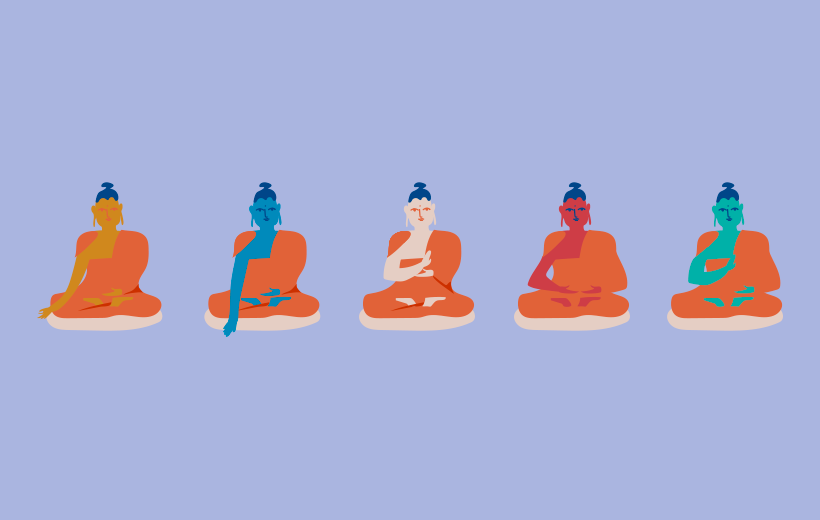Why Do We Suffer?
By Tergar Meditation Community • 5 min read
The very title of this article might make you want to, figuratively speaking, skip to the sports section or the funny pages. However, not only is it wise to consider the Buddhist view of suffering, it’s actually quite heartening. In popular imagination, Buddhism is often seen as equating life with suffering, but that’s not really accurate. In fact, Buddhism sees a lot of suffering as completely avoidable.

Mingyur Rinpoche describes suffering as being divided into two types, “natural suffering” and “self-created suffering.” The former is very straightforward, while the latter variety can sprawl out in all directions. Natural suffering is self-explanatory: it’s just an unavoidable part of being in a physical body, and to understand it, all you have to do is stub your toe, or have an attack of gallstones. Self-created suffering, on the other hand, is the worry and editorializing and other unnecessary mental activity that we bring to the equation. When we’re experiencing that type of suffering, we’re usually oblivious to the fact that we’re the ones generating it.
For example, imagine you have a bad toothache. If natural suffering had a voice, it might describe the situation something like this: “Ouch. Ow. Ouch.” About that exact same painful tooth, self-created suffering might describe it like so: “This is the worst toothache I’ve ever had. Probably they’ll have to pull it out — at huge expense. Why is my life like this? It’s my fault for not getting checkups. I’m such a mess . . . and now I’m going to be a toothless mess!” The extra layers of anguish we generate feel very vivid and real, and they exaggerate the situation of natural suffering. We’re also quite capable of creating suffering in anticipation of an event that has yet to happen — or with virtually no reason at all, apart from the idea of something that we find menacing (“If I go into that basement, I might see a spider!”). There’s a catch, though: we are not doomed to experience self-created suffering. We can liberate ourselves from it. That doesn’t mean we’ll never experience physical pain; it means we won’t be identified with it. Pain will be pain, but not “my pain,” not “me.”
“The Buddha identified mistaking impermanence for permanence as one of the primary causes of suffering.”
– Mingyur Rinpoche –
Classical Buddhist texts, of course, have much to say on the topic of suffering. The Sanskrit word dukkha doesn’t translate very well into any modern language, but it’s probably best translated as “dissatisfaction.” Dukkha has three primary aspects. The first is the suffering of change — the inevitable ups and downs of health and illness, praise and blame, wealth and poverty, and so on. We suffer from change when we cling to what we believe we need or want and aren’t open to accepting what’s actually happening. Secondly, there’s the concept of “suffering of suffering,” which is akin to the natural suffering that Rinpoche speaks of: by virtue of the fact that we’re living in a body, we will encounter pain, aging, illness, and eventually, of course, death. Lastly, there’s “all pervasive-suffering.” This term describes the general ambient anxiety that lurks in the background of even our most long-anticipated experiences, like the old Peggy Lee song “Is That All There Is?” It’s there because deep down, we’re afraid that life isn’t stable, and that our very existence is ambiguous. From a Buddhist point of view, there are excellent reasons to harbor such doubts, and exploring them is a path to wisdom and liberation.
Ultimately, the source of all the non-natural suffering we experience — that is to say, most of our suffering — resides in our entrenched yet mistaken views about how things are. You might call it “primordial ignorance.” To be free from the suffering that hounds us, we need to be able to uproot these false or erroneous perceptions. And happily, meditation gives us all the tools we need to do just that.
If you enjoyed reading our articles, please join our mailing list and we’ll send you our news and latest pieces.
In this talk, Mingyur Rinpoche talks about how we can free ourselves from self-created suffering.
Learn meditation under the skillful guidance of world-renowned teacher Yongey Mingyur Rinpoche at your own pace.

Tergar Meditation Community supports individuals, practice groups, and meditation communities around the world in learning to live with awareness, compassion, and wisdom. Grounded in the Tibetan Buddhist lineage of our guiding teacher, Yongey Mingyur Rinpoche, our online and in-person programs are accessible to people of all cultures and faiths, and support a lifelong path toward the application of these principles in everyday life.

“Each time I come back to Joy of Living, I get something totally new out of it. I also appreciate it’s a very sequential path as well. Each piece flows into the other very elegantly. It’s a work of art really.”

What if every emotion you’ve ever tried to get rid of — anger, jealousy, confusion — was actually a doorway to wisdom? The five buddha families offers such an exploration.

After overcoming self-doubt and joining the Meditation Teacher Program, Mark O’Donaghue is helping those behind prison walls by sharing the radical message that everyone — even those society has forgotten — is already whole, complete, and inherently good.
If you enjoyed reading our articles, please join our mailing list and we’ll send you our news and latest pieces.